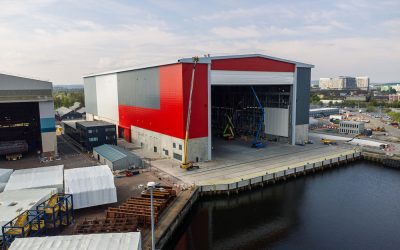German startup has disruptive ambitions for cloud-based 3D ship design platform
As a notoriously conservative industry it probably shouldn’t come as much of a surprise that ship design and construction wasn’t exactly among the pacesetters when it comes to cloud-based collaboration. However, a German startup company is hoping it can seize the advantage where other software platform providers have hitherto been less successful.
Officially founded in 2021, Naval Architect (no relation to RINA’s publication) is a 3D design tool created with the vision of making collaboration accessible and easy. Originally formed as a spin-off project of the University of Rostock, the company has ambitions of digitalisation in a range of industries but has identified shipbuilding as a priority area. The company already boasts a range of clients ranging from yacht-specialist shipyards to international design offices.
Sebastian Greshake, Naval Architect’s CEO and co-founder stresses to TNA that his company is not simply offering another CAD tool. He explains: “In a sense, one can recognize 3D-CAD as another step in the evolution from manual drafting to computer-aided drafting to creating kinds of 3D drawings which carry more and better information than pure 2D drawings.”
“Whether we talk about 2D or 3D, the process on how people work together hasn’t changed much in the last 100 years…We want to change the process: people should collaborate on a common model instead of maintaining their own drawings. That’s what is absolutely unique [about the company] and therefore we aren’t even afraid of large competitors. They would need to start a completely new product to compete with us.
Rather, Naval Architect is intended as a holistic system for improving the traditional ship design process, utilising a cloud-native software platform that acts as the single source of truth for all project related information, ranging from geometric data, specification. Adopting an API-first [Application Programming Interface] approach, its technology can be easily integrated with other software tools.
“The increase and optimisation of efficiency, reliability and collaboration in the ship design process are our key goals,” says Greshake, adding that today’s processes are best described as people burning through money by iterating changes through design documents and models, rather than the engineering tasks that actually add value to the project.
For example, a new project will typically begin with a first draft of the General Arrangement Plan (GAP) and a template or copy of a building specification of a similar vessel in the shipyard or designer’s portfolio. The GAP will often be a simple AutoCAD drawing, meaning that heights, lengths and volumes will all need to be calculated manually. Because the documents will change significantly as the project evolves, the measurements will need to be taken repeatedly and certain details may even get overlooked, resulting in costly corrections later on. But if the GAP and building specification are combined from the outset, so that the design’s geometric properties are directly aligned with the properties of components (density, thickness, etc.) the calculations would automatically update. Moreover, although the user creates a 3D model from the outset, this is largely a similarly automated process requiring minimal effort. Greshake says efficiency can be boosted by as much as 50% through eliminating manual double work.
Given the domination of legacy players, with little incentive to embrace the full possibilities of digitalisation, the much-promised ‘disruption’ of the industry is long overdue, but he believes the shift towards decarbonisation in particular is likely to create greater receptiveness towards new solutions.
He explains: “It will steadily increase the demand for newbuilds, retrofits and climate-friendly technologies in the near future. The maritime industry needs to not only implement these technologies on a larger scale and faster, but also more cost-effectively. These challenges require a modern underlying tech-stack and this is where Naval Architect comes into play.”
Like any startup, the company can’t rule out being acquired by one of the bigger fish as it seeks to build its reputation, but for the present the emphasis is on adding further components to the platform. This includes introducing an increased level of detail for modelling as well as reports (e.g. weight and cost calculation), as well as advanced functionality for its version control system.
“We aspire to become the leading software platform made for shipbuilding. Besides that, we might leverage our technology for other industries, e.g. the construction industry or the process and plant engineering space,” Greshake concludes.






